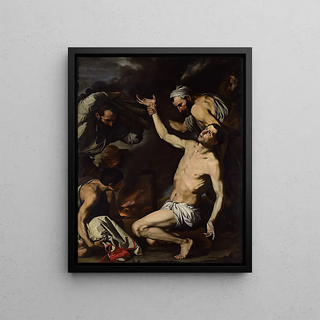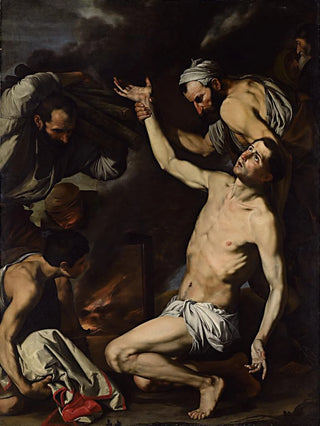Art print | Martyrdom of Saint Lawrence - Jusepe de Ribera


View from behind

Frame (optional)
The "Martyrdom of Saint Lawrence," an iconic work by Jusepe de Ribera, immerses the viewer in a world where suffering and faith intersect. This painting, created in the 17th century, reflects an era when baroque art asserted itself with strength, blending drama and spirituality. Saint Lawrence, a Christian martyr, is depicted in a moment of profound intensity, capturing the very essence of his sacrifice. The light, omnipresent in the piece, highlights the marked features of the apostle, revealing both the pain and serenity emanating from his figure. This masterpiece invites reflection on the human condition while offering a striking visual experience.
Style and uniqueness of the work
Ribera's style is distinguished by striking realism, where light and shadow play a leading role. In "Martyrdom of Saint Lawrence," contrasts are heightened, creating an almost theatrical atmosphere. The warm colors, dominated by earthy tones, evoke emotional depth, while the meticulous details of facial expressions and drapery demonstrate exceptional craftsmanship. Ribera does not merely depict physical suffering; he also explores its spiritual dimension. The saint's gaze, both desperate and hopeful, invites meditative contemplation. This work transcends the simple religious painting to become a true reflection on sacrifice and faith.
The artist and his influence
Jusepe de Ribera, often regarded as one of the masters of Spanish baroque, left his mark on his era with his ability to capture the human soul through his works. Originating from Spain, he spent part of his life in Italy, where he was influenced by artists such as Caravaggio. This influence is evident in his bold use of chiaroscuro and in his realistic portrayal of human figures. Ribera also contributed to popularizing religious themes, but in a way that engages the viewer on an emotional level. His work paved the way for many artists, and his impact is still felt today, both in the art world and

Matte finish

View from behind

Frame (optional)
The "Martyrdom of Saint Lawrence," an iconic work by Jusepe de Ribera, immerses the viewer in a world where suffering and faith intersect. This painting, created in the 17th century, reflects an era when baroque art asserted itself with strength, blending drama and spirituality. Saint Lawrence, a Christian martyr, is depicted in a moment of profound intensity, capturing the very essence of his sacrifice. The light, omnipresent in the piece, highlights the marked features of the apostle, revealing both the pain and serenity emanating from his figure. This masterpiece invites reflection on the human condition while offering a striking visual experience.
Style and uniqueness of the work
Ribera's style is distinguished by striking realism, where light and shadow play a leading role. In "Martyrdom of Saint Lawrence," contrasts are heightened, creating an almost theatrical atmosphere. The warm colors, dominated by earthy tones, evoke emotional depth, while the meticulous details of facial expressions and drapery demonstrate exceptional craftsmanship. Ribera does not merely depict physical suffering; he also explores its spiritual dimension. The saint's gaze, both desperate and hopeful, invites meditative contemplation. This work transcends the simple religious painting to become a true reflection on sacrifice and faith.
The artist and his influence
Jusepe de Ribera, often regarded as one of the masters of Spanish baroque, left his mark on his era with his ability to capture the human soul through his works. Originating from Spain, he spent part of his life in Italy, where he was influenced by artists such as Caravaggio. This influence is evident in his bold use of chiaroscuro and in his realistic portrayal of human figures. Ribera also contributed to popularizing religious themes, but in a way that engages the viewer on an emotional level. His work paved the way for many artists, and his impact is still felt today, both in the art world and






